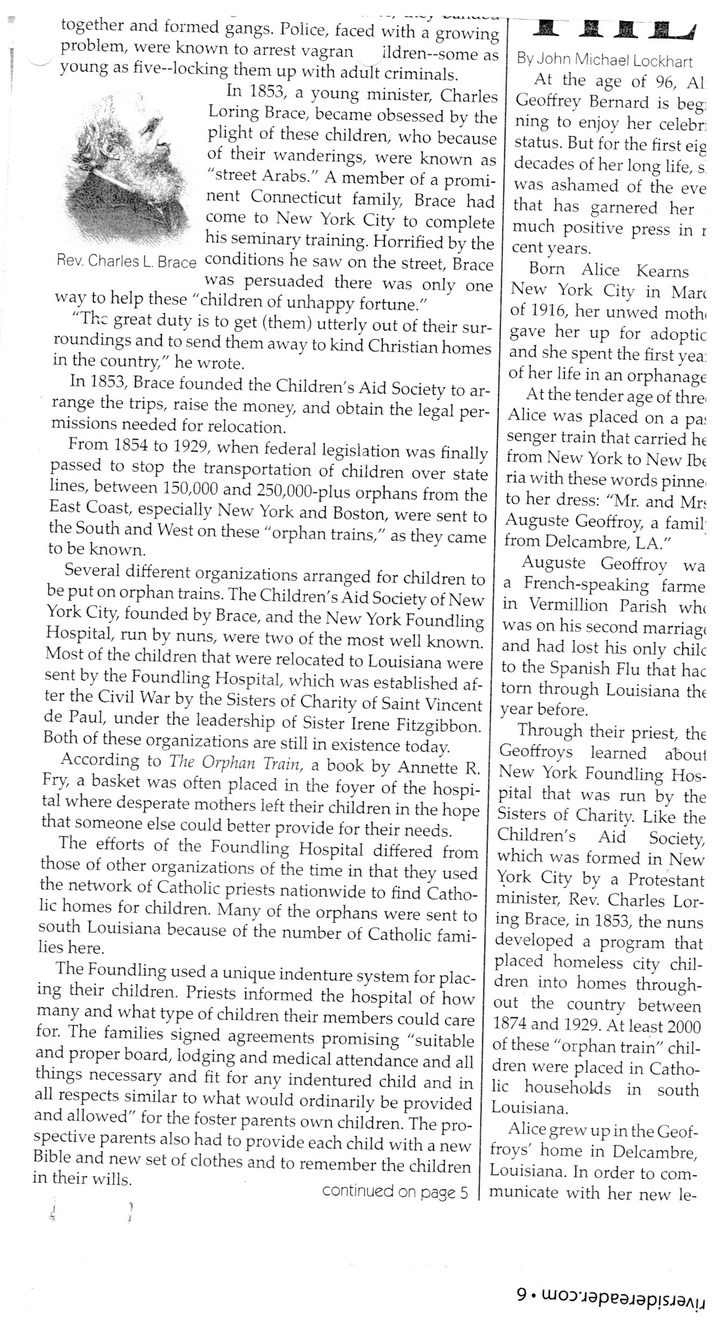This text was obtained via automated optical character recognition.
It has not been edited and may therefore contain several errors.
together and formed gangs. Police, faced with a growing problem, were known to arrest vagran ildren—some as young as five—locking them up with adult criminals. In 1853, a young minister, Charles Loring Brace, became obsessed by the plight of these children, who because of their wanderings, were known as "street Arabs." A member of a prominent Connecticut family, Brace had come to New York City to complete his seminary training. Horrified by the Rev Charles L Brace conditions he saw on the street, Brace was persuaded there was only one way to help these "children of unhappy fortune." "The great duty is to get (them) utterly out of their surroundings and to send them away to kind Christian homes in the country," he wrote. In 1853, Brace founded the Children's Aid Society to arrange the trips, raise the money, and obtain the legal permissions needed for relocation. From 1854 to 1929, when federal legislation was finally passed to stop the transportation of children over state lines, between 150,000 and 250,000-plus orphans from the East Coast, especially New York and Boston, were sent to the South and West on these "orphan trains," as they came to be known. Several different organizations arranged for children to be put on orphan trains. The Children's Aid Society of New York City, founded by Brace, and the New York Foundling Hospital, run by nuns, were two of the most well known. Most of the children that were relocated to Louisiana were sent by the Foundling Hospital, which was established after the Civil War by the Sisters of Charity of Saint Vincent de Paul, under the leadership of Sister Irene Fitzgibbon. Both of these organizations are still in existence today. According to The Orphan Train, a book by Annette R. Fry, a basket was often placed in the foyer of the hospital where desperate mothers left their children in the hope that someone else could better provide for their needs. The efforts of the Foundling Hospital differed from those of other organizations of the time in that they used the network of Catholic priests nationwide to find Catholic homes for children. Many of the orphans were sent to south Louisiana because of the number of Catholic families here. The Foundling used a unique indenture system for placing their children. Priests informed the hospital of how many and what type of children their members could care for. The families signed agreements promising "suitable and proper board, lodging and medical attendance and all things necessary and fit for any indentured child and in all respects similar to what would ordinarily be provided and allowed" for the foster parents own children. The prospective parents also had to provide each child with a new Bible and new set of clothes and to remember the children in their wills. continued on page 5 JL JSL JL M-J By John Michael Lockhart At the age of 96, A1 Geoffrey Bernard is beg: ning to enjoy her celebr: status. But for the first eig decades of her long life, s was ashamed of the eve that has garnered her much positive press in i cent years. Born Alice Kearns New York City in Marc of 1916, her unwed mothi gave her up for adoptic and she spent the first yea: of her life in an orphanage At the tender age of thre* Alice was placed on a pa: senger train that carried he from New York to New Ibc ria with these words pinne to her dress: "Mr. and Mr; Auguste Geoffroy, a famil from Delcambre, LA." Auguste Geoffroy wa a French-speaking farme in Vermillion Parish wh( was on his second marriagt and had lost his only chilc to the Spanish Flu that hac torn through Louisiana the year before. Through their priest, the Geoffreys learned about New York Foundling Hospital that was run by the Sisters of Charity. Like the Children's Aid Society, which was formed in New York City by a Protestant minister, Rev. Charles Loring Brace, in 1853, the nuns developed a program that placed homeless city children into homes throughout the country between 1874 and 1929. At least 2000 of these "orphan train" children were placed in Catholic households in south Louisiana. Alice grew up in the Geoffreys' home in Delcambre, Louisiana. In order to communicate with her new le- 9 • wcmapeajspjsjSAu

Orphan Train Riders of BSL Document (151)